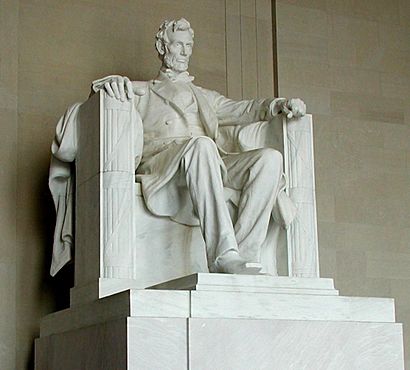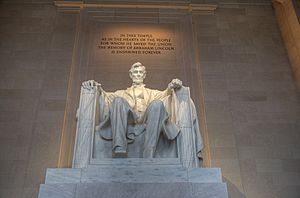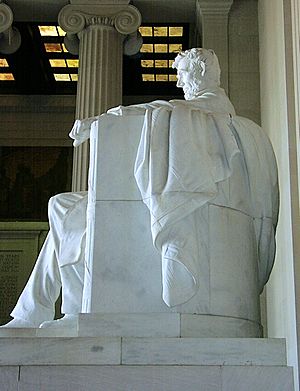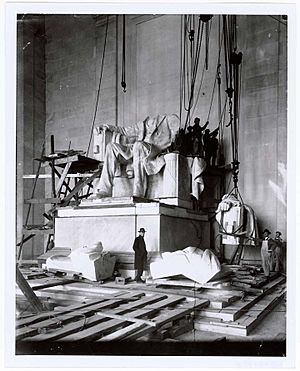Statue of Abraham Lincoln (Lincoln Memorial) facts for kids
Quick facts for kids Abraham Lincoln |
|
|---|---|
 |
|
| Artist | Daniel Chester French |
| Year | 1920 |
| Type | Georgia marble (Murphy Marble) |
| Location | Lincoln Memorial, Washington, D.C., United States |
| 38°53′21″N 77°03′00″W / 38.8893°N 77.050122°W | |
The Abraham Lincoln statue, finished in 1920, is a huge figure of the 16th President of the United States, Abraham Lincoln (1809–1865). It was created by Daniel Chester French (1850–1931) and carved by the Piccirilli Brothers. You can find this famous statue inside the Lincoln Memorial in Washington, D.C., United States. The memorial was built between 1914 and 1922, and the statue was shown to the public in 1922. This artwork is made in a classic style, like the Beaux Arts and American Renaissance art movements.
About the Statue
This giant statue weighs about 170 tons, which is like 170 small cars! It is made from 28 large pieces of white Georgia marble. The statue stands 30 feet (about 9 meters) tall from the floor. Lincoln himself is 19 feet (about 5.8 meters) tall, sitting on an 11-foot (about 3.4 meters) high base.
Lincoln looks straight ahead and slightly down, with a serious and thoughtful expression. His long coat is open, and a large American flag is draped over the back and sides of his chair. Daniel Chester French, the artist, paid special attention to Lincoln's hands. They rest on the large arms of a special chair. The front of the chair arms has symbols called fasces, which were signs of power in ancient Rome. French even used molds of his own fingers to make Lincoln's hands look just right.
How the Statue Was Made
In 1914, the Lincoln Memorial Committee chose Daniel Chester French to create the statue for the new memorial. French was already well-known for his 1874 statue called The Minute Man in Concord, Massachusetts. The architect of the memorial, Henry Bacon, also wanted French to do the work because they had worked together for almost 25 years. French started working on the statue in December after leaving his role on a special art commission in Washington, D.C.
French had already made another important standing statue of Lincoln for the Nebraska State Capitol in 1912. He had studied Lincoln a lot, reading biographies, looking at photographs, and even using a life mask of Lincoln made in 1860. This helped him prepare for the big task of creating the memorial statue. For the national memorial, French and Bacon decided that a large sitting figure would be best.
French began by making small clay models. Then he made several plaster models, changing the pose or setting a little each time. He decided to place Lincoln in a classic chair with Roman symbols of power, not just a regular 19th-century seat. This was to show that Lincoln was a very important person for all time.
Three plaster models of the statue are still at French's Chesterwood Studio in Stockbridge, Massachusetts. One of these, a six-foot plaster model from 1916, was later made much larger to become the huge marble statue. The statue was first planned to be a 12-foot bronze figure. To figure out the best size for the memorial, French and Bacon took large photos of the statue to the memorial while it was still being built.
The Piccirilli Brothers, who often worked with French, were chosen to carve the much larger sculpture from marble. The marble came from a quarry near Tate, Georgia. It took a whole year to transfer French's design onto the huge marble blocks. French added the final touches in the carvers' studio in The Bronx, New York City and after the statue was put together at the memorial in 1920.
Lighting the statue was a big problem. French had thought a large skylight would light the statue perfectly from above, but this was not included in the final plans. The light coming from the east made Lincoln's face look flat and highlighted his legs, which French thought was terrible. In the end, they used electric lights to fix the problem. The statue was officially shown to the public when the memorial opened on May 30, 1922.
The Hand Legend
There's a popular story that Lincoln is shown using sign language to spell his initials. People say his left hand forms an "A" and his right hand forms an "L." The National Park Service says this is just an urban legend and not true.
However, historian Gerald Prokopowicz says that while we don't know for sure if the sculptor Daniel Chester French meant for Lincoln's hands to be in sign language, it's possible. French knew American Sign Language because he had a son who was deaf. He might have wanted to honor Lincoln for signing a law that allowed Gallaudet University, a university for deaf students, to give college degrees. Another historian, James A. Percoco, notes that even though there are no old papers proving French did this, "I think you can conclude that it's reasonable to have that kind of summation about the hands."
See also
 In Spanish: Estatua de Abraham Lincoln (Monumento a Lincoln) para niños
In Spanish: Estatua de Abraham Lincoln (Monumento a Lincoln) para niños




